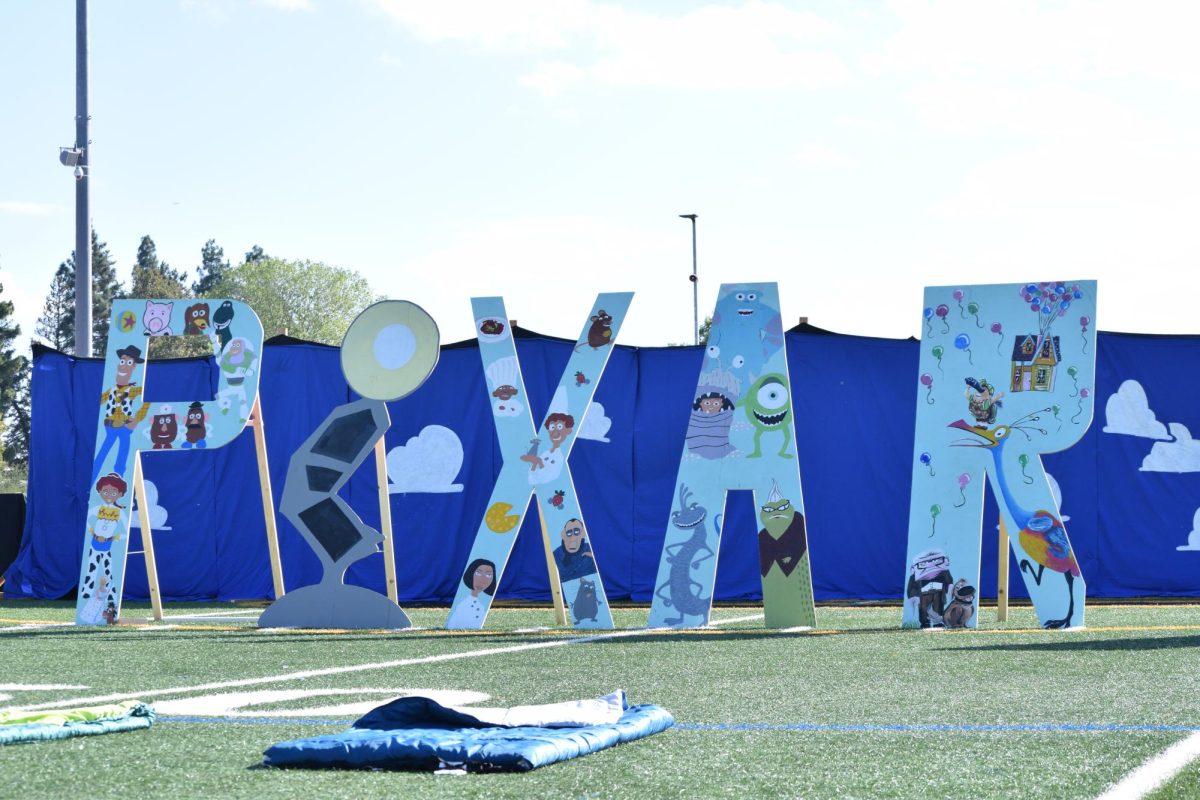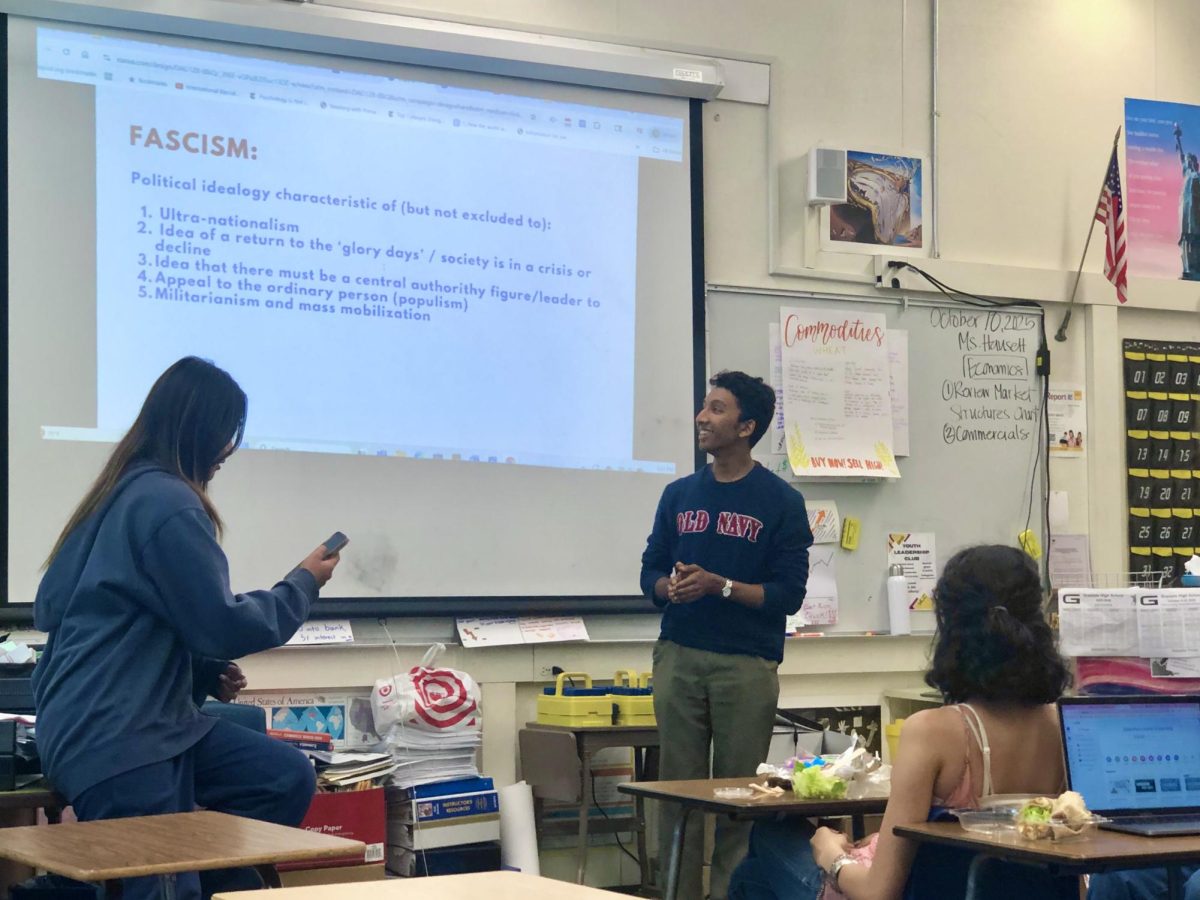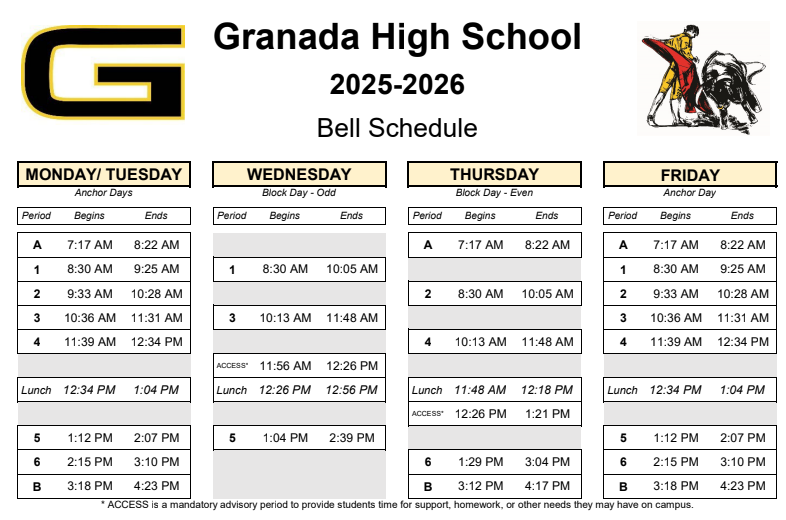Granada has adjusted its schedule twice since the 2022-2023 school year. The class of ‘27 alone has experienced this switch each year since they were freshmen, going from a trimester system, to a block schedule last year, all leading up to the brand new combination schedule today. But what’s changed and how are our students, teachers, and faculty handling this abrupt shift?
Long story short, last year’s block days came with several unforeseen challenges. For one, students were only seeing their teachers two or three times a week. This altered curriculum timelines for teachers and rushed the learning process for many students. These difficulties were especially prevalent in science courses, the math department, and in AP classrooms. For example, Amanda Cleveland, a Chemistry and AP Environmental Science teacher here at GHS, noted that “only seeing students twice a week sometimes resulted in students having more questions and not feeling like they had enough time to fully grasp the material before we had to move on again.” This led to widespread confusion and less motivation to prioritize understanding over doing the bare minimum exclusively for the purpose of completing assignments on time to keep up with the fast pace of courses.
In addition, those who were taking less than 8 classes, which was the case for the majority of the school, were not reaching the district-mandated amount of hours required for kids to be present on campus. This meant that the state would not approve our structural minutes, and that a new plan would need to be drafted as soon as possible. Thankfully no students were penalized in the mishap, and all credits will still be accounted for without need for make-ups.
Over the summer the district gathered together a committee of teachers, administrators, and district office personnel to decide what the schedule would look like going forward. Principal Clark Conover stated in an interview that one of the main goals in putting it together was to “increase the amount of face-to-face contact between students and teachers,” as last year students would only see their teachers five out of every ten days. Now that number has been raised to eight, which Conover believes to be a highly promising improvement. He also wanted to “create a balance between previous schedules because there were positives and negatives to both,” hoping that this hybrid would offer the best of both worlds.
The new compromise schedule, as Conover called it, consists of every full-time student enrolling in a total of 6 courses, with optional A and B periods before and after district-mandated school hours. Mondays, Tuesdays, and Fridays, students will attend all classes and have 55 minute periods. Wednesdays and Thursdays are block days for students to receive extra help from teachers or additional time to complete/retake tests, and work on assignments. Each period is 95 minutes, and being present in a classroom during ACCESS is mandatory.
Conover dove deeper into the potential benefits of this “study hall” period, voicing that he “went to visit schools, including Foothill, and they had an access period and what I thought was interesting is that some kids were making up tests. Valuable. Some kids were getting extra help. Very valuable. Some kids were socializing, which is also valuable. And some kids were just reading books or napping, which I think can be valuable too because students just need time. If kids can use our access for these things, I think that’s great.” He also cleared up the need for our traditionally optional ASE to be made a requirement by explaining how most students who needed it were not taking advantage of it in previous years.
But how are teachers and students adjusting to these changes? According to Cleveland, the new schedule is great “for getting lessons across to students.” She says that she enjoys having 55 minutes because it gives her time to truly go over a topic, and the blocks are equally useful because it allows more time for labs. With the curriculum being more spread out this year, “it gives my kids time to ask questions and gives me time to answer and explain.”
Furthermore, Kelly Siefering, one of our AP U.S. History teachers at Granada, stated that while altering the curriculum to fit the new timeframe took a lot of work, it was worth it due to its evident benefits in an AP setting. Especially in regards to homework, which “has been able to be more spread out with this schedule, which I think is less overwhelming for our students. We had to take out an entire unit last year due to timing issues which was very stressful.” Excitingly, Siefering claims to have already seen positive results even so early in the year with her junior APUSH class’ first multiple choice test scores, which she confirmed are “where [she] want[s] them to be, whereas last years was on the lower side.”
In regards to ACCESS, Siefering also commented on how she thinks “it’s a good break for students to get some work done.” Although it’s been a confusing adjustment for her so far, overall she feels like study hall is especially helpful for AP students because most have sports, extracurriculars, volunteering commitments, and more, so it’s a nice way to get some extra assistance.
Students have mixed feelings about the changes made to Granada’s bell schedule, but the general consensus has been mostly positive. For one student athlete, balancing school, sports, homework, extracurriculars, and friends has been a taxing feat. Scarlett Silz, a junior at GHS, offered her point of view being someone who endures flag football practice for at least two hours after school every day of the week. As many other student athletes may find relatable, she struggles with time management and balancing the demands of everyday life alongside her already busy daily routine. While Silz did mention how 55 minute periods are much easier to stay focused in rather than the 90 minute block days from last year, she also professed to the challenges from having six classes almost every day:
“I always go home exhausted and wanting to take a three hour nap. It can just feel very draining from time to time and we have so much homework to do now. Yesterday I had seven different homework assignments and had to stay up until around 1 am to finish it all.”
These frequent late night study sessions have not only taken a toll on Silz mentally, but also physically. Overstimulation has led to her feeling overwhelmed and unmotivated, which she finds concerning considering how early in the school year it is. Her only reprieve, she claims, is ACCESS. During our interview, Scarlett voiced that “the 25 minutes given on Wednesdays honestly aren’t enough. Thursdays are better but I still have an excessive amount of work when I get home.”
Overall, while feedback regarding the new arrangement has been pretty split, it is clear that there are many benefits worth noting. So now for the million-dollar question we’re all wondering: Is the new schedule subject to change again?
While teachers like Cleveland hope this will be the end of an era, Principal Conover is not so sure. There would be many things to consider if rearranging the schedule again were to be added to the agenda, including how to align statewide requirements with student and teacher preferences, but Mr. Conover is open to suggestions and welcomes student input. For now though, rest assured that nothing has been confirmed. Conover maintains the stance that “everything could change, but [he] would be surprised if it were to happen as early as next school year. There might be little tweaks regarding ACCESS or lunch, but for now, it’s up in the air.”
































